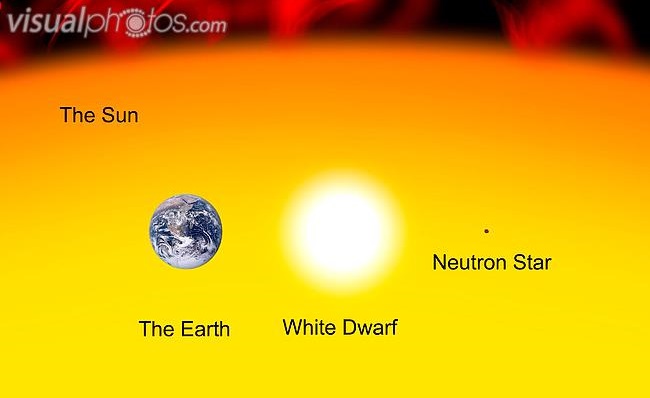
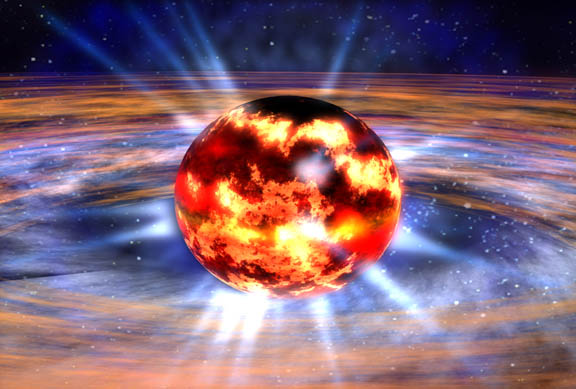
In astronomy, most celestial objects are fairly large in size, and if they are small, they don’t usually present much interest (generally, stars are a tad more interesting than comets). However, this is not a rule (and even if it were, rules are meant to be broken). There are always exceptions….like neutron stars.
A neutron star is a type of stellar remnant created in the core of massive star during a supernova (Type II, Ib or Ic) . Due to the gravitational collapse of the star’s core, every remaining proton with a corresponding electron is ‘crushed’ by gravity into nothing more than neutrons and neutrinos.
Neutrons are subatomic particles with no electrical charge, and a slighter higher mass than a proton. Due to quantum degeneracy pressure neutron stars are supported against further collapse. This is described by the Pauli Exclusion Principle, which states no two neutrons can occupy the same place and quantum state simultaneously (meaning that they can’t be squished any more than they already are, or they would violate this principle).
HOW ARE NEUTRON STARS FORMED?
When most people think of a supernova, they think of a large explosion resulting in the creation of a black hole; however the initial mass of the exploding star plays a part in determining whether or not the it will form a black hole or a neutron star. Any main sequence star with a mass from 8 to 30 times the mass of our own Sun (solar mass) has the potential to become a neutron star.
If the mass is over 30 solar masses, then the star will collapse into a black hole; on the other hand, anything under 8 solar masses will likely become a white dwarf. It is thought that most supernovae form neutron stars instead of black holes, leading to the possibility that as many as 10^9 neutron stars have formed in our galaxy’s 13 billion year life span.
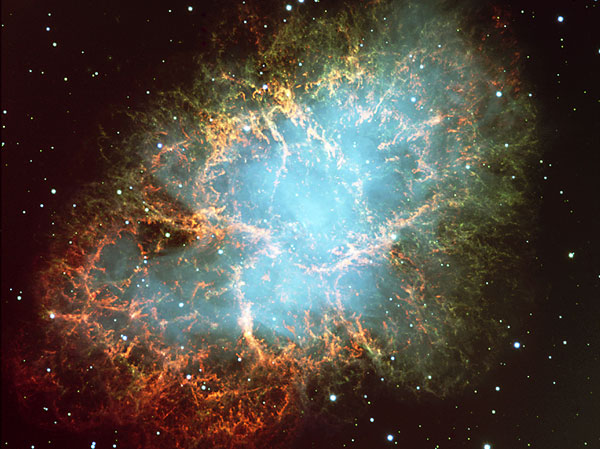
While the supernovae’s expanding shell of gas and dust can cover countless miles of space, a neutron star usually has a radius of no more than 12-13 km/7-8 miles (the size of a small city, or about 60,000 times smaller than our own Sun!). For example, the gas and dust shell known as the Crab Nebula, in the constellation of Taurus, has a radius of 5.5 light-years (and continuously expanding at a rate of approximately 0.501% of the speed of light per second). The other result of a supernova is a black hole, which is similar to a neutron star in size.
The event horizon of these objects average approximately 30 km/18 miles in diameter. Of course, black holes are not confined to the same size limits as neutron stars are.
Evidence of this can be found by studying supermassive black holes, which are amazingly massive objects; however, that is a topic for another day.
PUTTING SCALE TO A NEUTRON STAR:
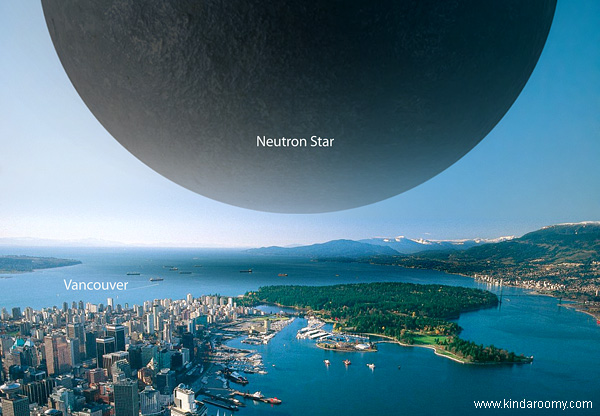
Though neutron stars are much smaller in size, what they lack for in physical size they certainly make up in the mass. Neutron stars are incredibly dense; so dense in fact, that it is comparable to taking a Boeing 747 and compressing it to the size of a grain of sand.
NASA has broken this density down into layman’s terms by stating “One sugar cube of neutron star material weighs about 100 million tons, which is about as much as a mountain.” Similar to their white dwarf counterparts, the heavier a neutron star is, the smaller its overall diameter will be.
These figures were obtained using the lowest density neutron star; however, scientists believe the density can be upwards of double or triple the lowest density.
PULSARS: NEUTRON STARS (WITH A TWIST):
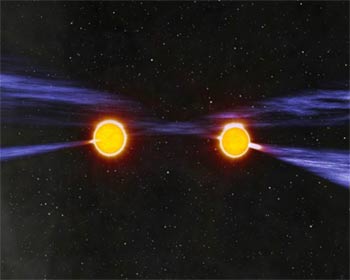
Some neutron stars form pulsars, which spin at a rapid rate usually emitting beams of electromagnetic radiation; however, pulsars have subsequently been found to emit visible light, X-ray, and Gamma ray wavelengths.
While pulsars are generally created from a star collapsing into a neutron star, they can also be created by the merger of two binary neutron stars. As mentioned earlier, it is thought our galaxy contains as many as 10^9 neutron stars; however, they are only easily detectable if they are a pulsar or part of a binary system.
The Hubble Space Telescope discovered a thermally radiating neutron star known as RX J1856.5-3754. Created over 1 million years ago, it took scientists 10 years and data from both Hubble and Chandra to confirm it was a neutron star and not a quark star. It is part of the “Magnificent Seven,” a group of young neutron stars approximately 200-500 parsecs from Earth.
PULSAR VARIABILITY:
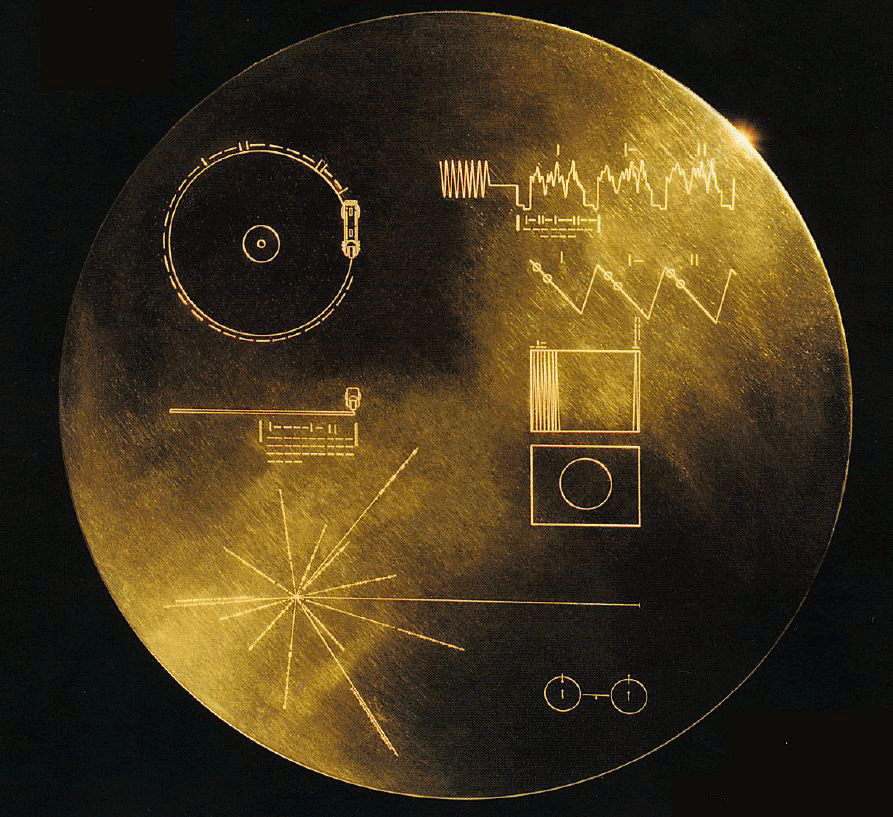
It wasn’t until the discovery of pulsars in 1967 that astronomers were able to study a neutron star – mostly due to the inability to see such a small object from land based telescopes at the time. The first pulsar, CP1919, was picked up on radio telescopes on November 28 1967 by Jocelyn Burnell and Antony Hewish, who calculated the pulsars “pulse” or rotation to be 1.33 seconds.
At first, this sound was thought to be a radio communication from another intelligent life form, and was even named LGM-1 for Little Green Men. Pulsars “pulse” at a consistent rate and are even used as astronomical clocks. One variety of extremely rapid pulsars, known as millisecond pulsars (MSP’s) rotate as fast as 1-10 times a millisecond! MSP’s rival atomic clocks in accuracy.
PSR B1937+21 is one such example, and has a rotation of 1.5578065 ms.
Pulsars are atomic beacons, acting as lighthouses in space; each with their own unique timing signature helping astronomers map out galaxies. In fact, the Pioneer plaques and the Golden Record aboard Voyager 1 contain a pulsar map, showing the location of our Sun relative to 14 different pulsars and enabling any who might find it the means to navigate their way back on Earth.
Want to know what a pulsar sounds like? To find out click here.